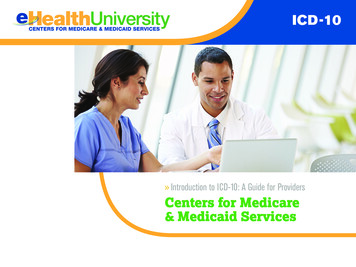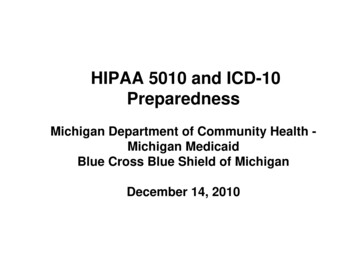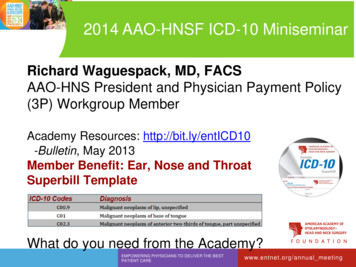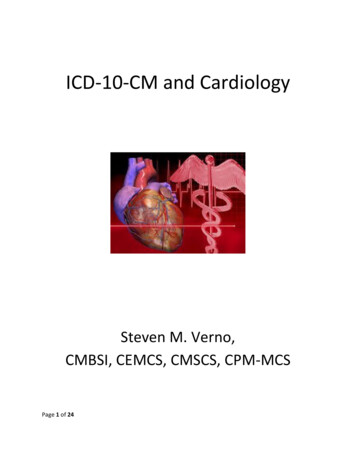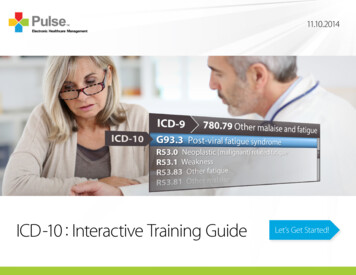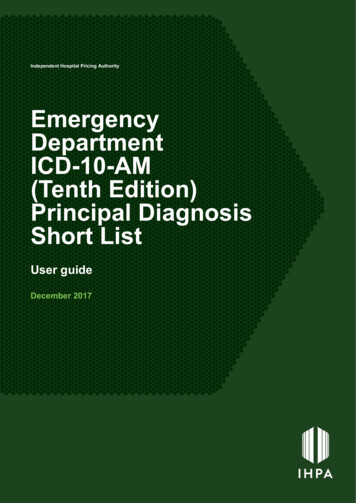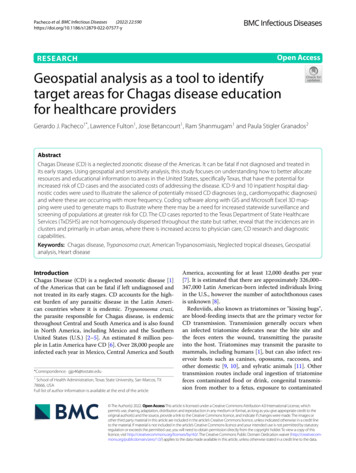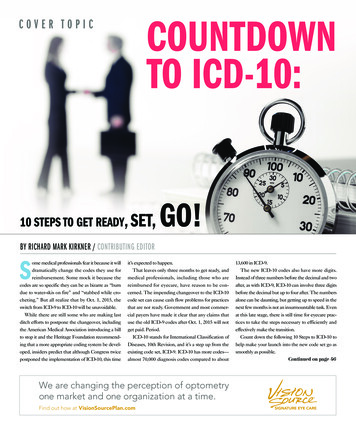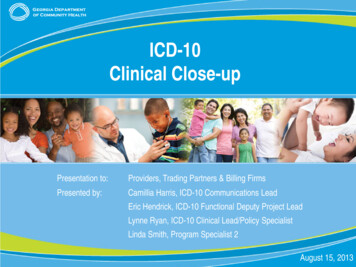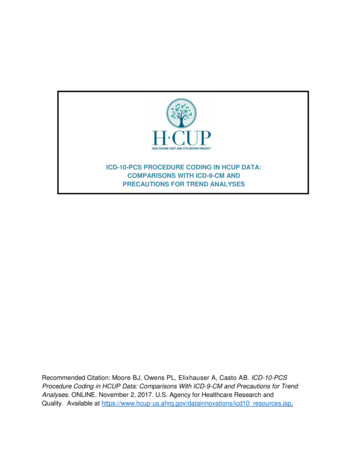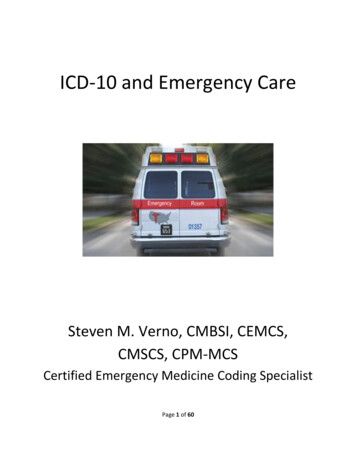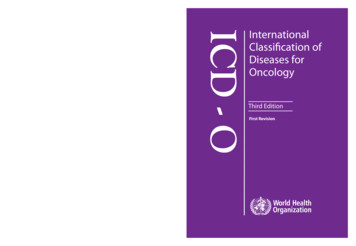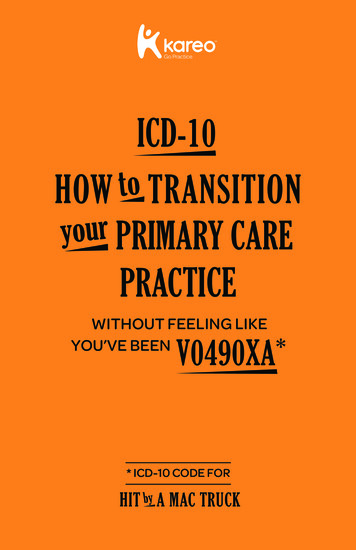
Transcription
ICD-10HOW to TRANSITIONyour PRIMARY CAREPRACTICEWITHOUT FEELING LIKEYOU’VE BEENV0490XA** ICD-10 CODE FORHIT by A MAC TRUCK
TABLE OF CONTENTSWhat’s the Code for ICD-10 Success?. 1What Is ICD-10? Laterality Anatomical Site or LocationCombination Codes Type of Encounter Coding GuidelinesChanges for Primary CareStep 1: Get Educated. 8Why Train Educational Resources Who to TrainWhen to Train Where to Find TrainingStep 2: Review Coding & Documentation.11Documentation Improvement Code Mapping Sample Code MapStep 3: Analyze Your Workflow. 14Document Review Workflow ReviewStep 4: Develop a Financial Plan.16ICD-10 Budget Cash Reserves Cost ContainmentStep 5: Test, Test, Test. 20Edited by Lea Chatham 2015 Kareo, Inc
How to Transition Your Primary Care PracticeWHAT’S THE CODE FOR ICD-10 SUCCESS?Ok, there isn’t really a code for ICD-10 success but if there was it would beplan, plan, plan. The majority of practices have done little or nothing toprepare for ICD-10. This could be disastrous. An effective transition requiresplanning and preparation to mitigate the potential financial impact as muchas possible.What Is ICD-10?On October 1, 2014, medical coding as we know it will change forever.Everyone covered by the Health Insurance Portability and AccountabilityAct (HIPAA) must be compliant with ICD-10 on that date—not just those whosubmit to Medicare and Medicaid.ICD-9ICD-10Diagnosis Codes are 3-5charactersCodes are 3-7 charactersApproximately 14,000 codes69,000 codesFirst character is numeric oralpha (E or V) and characters2-5 are numericFirst character is alpha, characters2 and 3 are numeric, 4-7 arealpha or numericDifficult to analyze data due tononspecific codesExpanded to allow more specificityand accuracy resulting in improveddata analysisNo other country uses ICD-9—limiting interoperability with othercountriesUnited States is one of last majorcountries to transition to ICD-10Table 1. Differences Between ICD-9 and ICD-10www.kareo.com 1
How to Transition Your Primary Care PracticeICD-10 will impact many areas of your practice and touch every employee.And it will affect your primary care practice in unique ways. Advancedpreparation is the key to success.The first thing to do before you start planning for your ICD-10transition is to understand what ICD-10 is and how it differs fromICD-9 (table 1). Specifically, you need to know what aspects of ICD-10may impact your primary care documentation, coding, and billing.LateralityUnlike ICD-9, ICD-10 specifies left, right, and bilateral. For example, a patientpresents with a cyst on his or her eyelid. To properly report the ICD-10 codefor this condition, physicians must document whether the cyst is on the rightor left lid. They must also specify upper versus lower lid.Although ICD-10 provides an option for ‘unspecified eye,’ payers will likelynot accept this code (H02.829) because it provides very little clinical information. Physicians should crosswalk any diagnoses on their superbill fromICD-9 to ICD-10 to determine whether any of the conditions require laterality.Laterality is a common theme throughout ICD-10, so it’s likely that at leastone condition on a superbill will be affected.Anatomical Site or LocationICD-10 requires far more detail in terms of the location of an injury orcondition. For example, a patient presents with a cerebral infarction due toan embolism. Physicians must document precisely where the embolismoccurred, including laterality as well as the specific artery (i.e., in the precerebral artery, carotid artery, basilar artery, vertebral artery, middle cerebralartery, anterior cerebral artery, posterior cerebral artery, or cerebellar artery).Physicians should thoroughly read the ICD-10 code descriptions pertinentto primary care to understand what type of clinical detail is required.2 www.kareo.com
How to Transition Your Primary Care PracticeCombination CodesICD-10 includes hundreds of combination codes (i.e., codes that linksymptoms, manifestations, or complications with a particular diagnosis).For example, ICD-10 code I25.10 denotes atherosclerotic heart disease ofnative coronary artery without angina pectoris. Code I25.11- denotes atherosclerotic heart disease of native coronary artery with angina pectoris. Thesixth digit specifies more information about the angina pectoris (e.g., whetherit’s unstable or with documented spasm).To report combination codes correctly, documentation must clearly indicatethe presence of the symptom, manifestation, or complication along with thepertinent condition to which it corresponds. Documentation must also linkthe two together (e.g., coronary artery disease with unstable angina).Type of EncounterSome ICD-10 codes specify whether the encounter is initial, subsequent, orsequela. For example, a patient presents with a laceration of his or her righthip tendon. Physicians must document the type of encounter so coders canassign the 7th (and final) character in the ICD-10 code. An initial encounteris one in which the patient receives initial active treatment. A subsequentencounter is one in which a patient receives routine care during the healingor recovery phase. A sequela encounter is one in which a patient receivestreatment for complications or conditions that arise as a direct result of acondition. The 2015 ICD-10-CM Official Guidelines for Coding and Reporting provides examples of each.The type of encounter is requiredfor valid submission of certaincodes. Those working in the orthopedic specialty should pay closeattention to the 7th character, as itmay also include other importantinformation, such as the type ofhealing (i.e. routine, delayed,nonunion, or malunion).www.kareo.com 3
How to Transition Your Primary Care PracticeICD-10 Coding GuidelinesPhysicians who assign their own codes must—at a minimum—read the CDC’s2015 ICD-10-CM Official Guidelines for Coding and Reporting. This document is a treasure trove of information that includes little known facts aboutthe new coding system physicians could easily overlook. For example, ICD-10requires inclusion of a placeholder character ‘X’ for certain codes to allowfor future expansion. Code category T36-T50 (poisoning by, adverse effectsof, and underdosing of drugs, medications, and biological substances) is oneexample.ICD-10 codes can range in length from three to seven characters, includingplaceholders. Only complete codes will be considered valid. Review theguidelines for more information about coding conventions and diagnosticreporting for outpatient services.Changes for Primary CareICD-10 will allow primary care specialists to more accurately depictchronic conditions as well as other commonly reported diagnoses.Following are some diagnoses primary care specialists should pay attentionto, although this is by no means an all-encompassing list. While these providea guide to how things will change, practices should examine their own topdiagnoses and compare how those codes will change once ICD-10 goes intoeffect (see Step 2: Review Coding & Documentation).4 Headache. ICD-10 includes a slew of codes for headaches. For example,when a patient presents with a migraine (code G43), physicians mustspecify whether it’s common, hemiplegic, persistent, chronic, ophthalmologic, abdominal, or menstrual.Cluster headaches and other trigeminal autonomic cephalgias (codeG44.0) are grouped into episodic, chronic, episodic paroxysmal hemicrania, chronic paroxysmal hemicrania, and short-lasting unilateralneuralgiform headache with conjunctival injection and tearing.4 www.kareo.com
How to Transition Your Primary Care PracticeThere are also codes for vascular headaches (G44.1), tension-typeheadaches (G44.2), post-traumatic headaches (G44.3), drug-inducedheadaches (G44.4), as well as a variety of other headache syndromes.Many of the codes in the headache section also require the followingdocumentation: With or without aura Intractable versus not intractable With or without status migrainosus4 Depression. The Centers for Disease Control and Prevention estimatesthat one in 10 adults reports depression. Depression codes have beengreatly expanded in ICD-10. When a patient presents with major depression (codes F32-F33), physicians must document the following: Single episode versus recurrent Mild, moderate, or severe With or without psychotic features In partial or full remission4 Ear Infection. ICD-10 includes various codes to denote specific formsof a middle ear infection. These codes are grouped in H65-H67 anddistinguish between the following forms of otitis media: Serous Allergic Mucoid Nonsuppurative Suppurative Tubotympanic suppurative Atticoantral suppurativewww.kareo.com 5
How to Transition Your Primary Care PracticePhysicians must also document the following information for manyof the codes in this section: Acute versus chronic Laterality (left versus right versus bilateral) Any associated perforated tympanic membrane4 Hypertension. ICD-10 code I10 denotes essential (primary) hypertension. There are separate codes for hypertension involving vessels ofthe brain (codes I60-I69) and hypertension involving vessels of the eye(code H35.0).ICD-10 also includes codes for hypertensive heart disease with or without heart failure (code I11), hypertensive chronic kidney disease (codeI12, Note that physicians must document the stage of the chronic kidneydisease), hypertensive heart and chronic kidney disease (code I13), andsecondary hypertension (code I15).4 Diabetes. Diabetes (codes E08-E13) has greatly expanded in ICD-10.Physicians must document whether the diabetes is Type 1, Type 2,drug- or chemical-induced, or due to an underlying condition. They mustdocument the specific underlying condition, the specific drug or toxin,as well as the use of any insulin. ICD-10 requires very specific detailsregarding any complications or manifestations of the diabetes. Forexample, code E08.341 denotes diabetes mellitus due to underlyingcondition with severe nonproliferative diabetic retinopathy with macularedema. A careful review of diabetes codes is required to ensurecompliance.6 www.kareo.com
How to Transition Your Primary Care Practice4 Asthma. Asthma (code J45) is another diagnosis that was expanded inICD-10. Physicians must document whether the asthma is: Mild intermittent Mild persistent Moderate persistent Severe persistentThey must also specify whether the asthma is uncomplicated, with acuteexacerbation, or with status asthmaticus.4 General Health and Preventive Care. Chapter 21 of the ICD-10 Manualincludes a whole slew of codes related to factors that influence healthstatus and contact with health services. For example, primary carephysicians may be interested in codes Z55-Z65, which pertain to healthhazards related to socioeconomic and psychosocial circumstances.Codes in the Z68 category denote specific data related to body massindex. Codes in the Z72 category denote problems related to lifestyle(e.g., tobacco use, lack of exercise, and high-risk sexual behavior).This chapter also includes codes for preventive care, such as Z01.3(encounter for examination of blood pressure), Z01.4 (encounterfor gynecological exam), and more. It’s worth reviewing this chapterin more detail.www.kareo.com 7
How to Transition Your Primary Care PracticeSTEP 1: GET EDUCATEDWhy TrainDon’t assume you can send your coder or biller to training and call it done.ICD-10 affects virtually everyone in the practice in some way. It is importantfor everyone to learn how ICD-10 may affect their role—only then can youplan education and training accordingly.Practice ManagerNew PoliciesUpdates to Payer ContractsBudgeting/Financial PlanningNew Forms/Software ChangesFront DeskPrior AuthorizationsBilling & CodingPayer ChangesCoding ChangesSoftware ChangesClinical ProvidersCoding ChangesDocumentation ChangesSoftware ChangesEducational ResourcesGet everyone up on the basics with these 10watch.comwww.aapc.com8 www.kareo.com
How to Transition Your Primary Care PracticeOrder the ICD-10 coding handbook for training and evaluating the equivalentcodes for your ICD-9 codes. Here are a couple of good tools: ICD-10-CM 2015 Codebook from the AMA ICD-10-CM Mappings 2015 from the AMAWho to TrainOne cost effective strategy is to send an individual in the practice, or in alarger practice a group of individuals, to training (online or in person). Thenhave trained staff come back and train others.This is a great solution for small practices. Send your biller or coder to atraining (especially anyone who needs to update certification) and then havethat person come back and train people in other roles on just the tasks thatare pertinent to them.In larger practices it might be all certified coders along with one person fromeach group (a front desk person, a nurse, a doctor, etc.). Larger practicesmight also consider having someone come in to do training on site for everyone. There is a tipping point where this is actually more cost effective.When to TrainICD-10 training should begin as soon as possible. Not only does this givestaff members more time to adjust to the new code set, but it also helpsto mitigate any productivity losses during the training period. Training canbe incremental and staggered so as not to affect daily responsibilities,particularly in smaller practices.Proactive training also ensures that practices can find a course with acertified and experienced trainer. Currently, there is a shortage of coursesand trainers.Where to Find TrainingAHIMA, the American Academy of Professional Coders, and a variety of othereducational providers offer training that is specific to coders, physicians, oroffice/clinic (non-coding) staff members. Opportunities range from onlinelearning to audio conferences to live events, and more. The cost and timewww.kareo.com 9
How to Transition Your Primary Care Practicecommitment varies based on the complexity of training. For a certified coderit may require as much as two days and cost as much as 1,500. However, ashort, half-day online training for a biller may only be 250. Planning aheadcan also help you plan for these costs appropriately.Physicians may be able to get the education that need from medicalsocieties and software vendors. There are even CME courses available insome cases.Talk to your practice management, billing, and EHR vendors about softwarechanges, what training will be available for users, and when it will occur.10 www.kareo.com
How to Transition Your Primary Care PracticeSTEP 2: REVIEW CODING & DOCUMENTATIONDocumentation ImprovementProviders may not want to hear this, but the single biggest issue to beaddressed in transitioning may be the increased need for documentation.After October 1, 2014, the old order for documentation standards will nolonger suffice. The new order requires greater detail.The truth is that many physicians do not document for specificity withcurrent ICD-9 codes and this will make implementation of ICD-10 codingfrustrating. To make it a little easier, start making changes now!Coders and billers can’t diagnose or assume a diagnosis. The cliniciansmust specifically document the presenting symptoms or chronic and acuteconditions in detail. Providers will need to understand the expanded codedescriptors, and these should be mirrored in their medical record dictation/documentation.Think about hiring a clinical documentation improvement (CDI)specialist or a consulting company to formally audit your documentation. A CDI specialist is someone—often a nurse or certifiedcoder with a clinical background—who helps physicians improve theirdocumentation so it accurately reflects patient severity of illnessand meets regulatory requirements. Although ICD-10 won’t requirephysicians to change the way they document, it does require youto be more mindful of specificity. Accountable care organizations(ACOs) are already engaging CDI specialists to ensure that thephysicians in their affiliated practices are documenting appropriately—you can hire these specialists, too!www.kareo.com 11
How to Transition Your Primary Care PracticeComplete and detailed documentation helps physicians organize theirobservations and examination, justify their treatment plan, support thediagnoses, and document patients’ progress and outcomes. The medicalrecord is a vehicle of communication for providers to evaluate, plan, andmonitor patients’ care and treatment. Documentation also supports severityof illness, length of hospital stay, and risk of morbidity/mortality data.Code MappingIn addition to improving documentation, providers, coders, and billers needto get comfortable with the new codes. Code mapping is a technique thatcan help you prepare for ICD-10. By mapping your most commonly usedICD-9 codes to their ICD-10 equivalents you can get familiar with your newcodes before the transition.Code Mapping adds five (5) key benefits to your practice.1.It enables you to gain an understanding of the structure of the ICD-10codes specific to your specialty.2.It helps you understand the equivalent ICD-10 codes and determine ifmore specific documentation is required.3.Once you start using ICD-10, it will improve the accuracy of your billing.4.It guides changes to documents and forms.5.It helps you plan and customize your staff training.The complexity of your mapping process will depend largely on your uniquepractice and/or specialty. For some, it will be straightforward because of thelimited number of codes currently employed by the practice (i.e., pediatrics).For others, it will be more complex because of the current range of codesutilized to diagnose patients (i.e., internal medicine).12 www.kareo.com
How to Transition Your Primary Care PracticeSample Code MapTable 2 is an excerpt from a code map for an internal medicine practice. Thetop 20 diagnosis codes by frequency as a primary or secondary diagnosisfrom the previous ten months were identified, and then mapped to theequivalent ICD-10 codes. Depending on the complexity of your practice, itmay be more appropriate to identify the top 50 or even top 100 codes tomap.RankICD-9CodesICD-9 01.9Unspecified essentialI10Essential (Primary)hypertension Hypertension2414.003427.31Coronary atherosclerosisI25.10of unspecified type ofvessel, native or graftAtherosclerotic heart diseaseof native coronary arteryw/o angina pectorisAtrial fibrillationI48.0Paroxysmal atrial fibrillationI48.2Chronic atrial fibrillationI48.91Unspecified atrialfibrillation4599.0Urinary tract infection,N39.0Urinary tract infection,site not specified5250.00Type 2 diabetes mellituswithout complicationsOther specified diabetesmellitus w/o complicationsDiabetes mellitus withoutE11.9mention of complication,E13.9type II or unspecified type,not stated as uncontrolledTable 2. Sample Code Map Excerptwww.kareo.com 13
How to Transition Your Primary Care PracticeSTEP 3: ANALYZE YOUR WORKFLOWICD-10 could affect many aspects of your practice’s workflow. You will needto evaluate your current workflow to look for areas where you need to makeupdates or changes and identify potential delays.Document ReviewThe first change in process took place in January 2014 with the release of thenew CMS 1500 v02/12 paper claim form. CMS now requires the use of thisform. Other payers will transition at their own pace so you may be using twodifferent versions on the CMS 1500 form for a period of time.Depending on how automated your processes are, there could be otherprinted forms that need to be updated. So, do a form review and look fornecessary changes to accommodate ICD-10. Some of the forms that mayneed to be revised include paper superbills, referral forms, x-ray forms,laboratory forms, authorization forms, and any other forms that use diagnosis codes. If you are still doing many of these tasks manually, this is a goodtime to consider a switch to an electronic option. It can eliminate or reducethe need to update and reorder many common paper forms.Workflow ReviewThis is a significant change to the way you document and code visits and billpayers. As with any change in the clinical process, there may be delays asproviders get used to changing documentation and coding. This could betrue for billers and coders as well. They will probably find that they have torequest additional information from providers and spend a little more timecompleting claims.14 www.kareo.com
How to Transition Your Primary Care PracticeIn addition, since there is no way to know how well your payers will do with thechange, your billing staff could also be spending more time on claim follow upfor a period of time. It’s worth your while to plan for an increase in workloadfor billing staff for at least a short period of time.As you prepare for the change, keep these potential workflow issues in mind.Depending on the comfort level of providers and staff, it may be wise toreduce patient visits for a month or two while you adapt. If you do choose todo this, be sure to factor the cutback into your financial planning (See Step 4:Financial Planning).www.kareo.com 15
How to Transition Your Primary Care PracticeSTEP 4: FINANCIAL PLANNINGICD-10 will impact your revenue—both now and after the transition.There is more to this change than training and code mapping—your practicemay not survive without thoughtful financial planning.There are three basic pieces to your ICD-10 financial planning:1.Planning for added expenses related to training and preparingfor the transition.2.Identifying what you will need for cash reserves to protect yourpractice in the event of a reduction in revenue and productivity.You’ll need to save that money or work with your bank to establisha line of credit.3.Looking at ways to contain costs and reduce expenses in caseyou do see a revenue shortfall.ICD-10 BudgetBecause ICD-10 requires training, updates to forms, changes to workflow,and the purchase of new resources, it needs a budget. It doesn’t have tobe fancy, but take some time to create a spreadsheet and list out all thepotential expenses (table 3). Can you accommodate them in your normalmonthly budget or do you need to set aside some extra funds to cover thosecosts. The sooner you figure it out the more time you have to spread outthe expenses. Remember to look at both your practice costs and the costsassociated with training each employee as appropriate.Cash ReservesMany experts are suggesting that you should expect to see a reduction inproductivity and revenue for about three months of up to 50% (and somesay as much as six months). You’re a small business with bills to pay so youneed to plan for a potential loss of revenue. If you can’t pay your rent, utilities,and employees, it will be hard to keep the doors open.16 www.kareo.com
How to Transition Your Primary Care PracticeExpenseTrainingExampleStaff 1 250Workbooks 99Travel0Salary 120Temp Staff(to cover for staffduring training)0Overtime0Lost Revenue(if you close theoffice for training)New Forms 200AdditionalCoding Books 99OtherSubtotalTotal Expenses 768Table 3. Sample Budget SpreadsheetThe more prepared and well trained you are, the less impact ICD-10 shouldhave, but you can’t predict how the transition will go with your payers. Whileyour own staff may do fine, there could be delays with payers that you can’tdo anything about. If you can set aside enough cash reserves (or qualify fora line of credit) before October, 2014 then you’ll be prepared for whateverhappens. Use the following steps to plan:1.Total your last 12 months of revenue and divide by 12 to get youraverage revenue per month.2.Divide your average revenue per month by two.3.Multiply that number by three.www.kareo.com 17
How to Transition Your Primary Care PracticeHOW TO CALCULATE SUFFICIENT RESERVES— 12 STEP 1.12 Monthsof RevenueAverageRevenueper Month— 2STEP 2. AverageRevenueper Month50% ofAverageRevenueper Monthx 3STEP 3.50% ofAverageRevenueper Month SufficientCashReservesCost ContainmentSetting aside reserves or getting a line of credit for ICD-10 may not beenough. When you combine additional expenses for several months with lossof revenue for up to three months or more, you might want to look at how youcan cut expenses in your business.Managing expenses and containing costs is actually something you shoulddo on a regular basis as part of your annual budgeting. Here are several areasto review and consider:1.Reduce Utilities. You should always be looking at ways to minimizecosts for electricity, Internet, phones, etc. Watch for competitive ratesand special offers that may reduce these expenses.18 www.kareo.com
How to Transition Your Primary Care Practice2.Review Contracts and Leases. Review all your vendor contracts andleases each year and get competitive quotes from at least two or threeother vendors. Also, look for ways to reduce usage for printers, copiers,and other equipment. With more automated solutions, some of theseitems may become obsolete.3.Automate or Outsource Processes. If you are still doing many practicemanagement, billing, and clinical tasks manually, now is the time toautomate or outsource. For example, manually processing paperstatements can easily cost two or three times what it costs to use astatement service. Using a medical billing service is often a lessexpensive alternative to having full time billing staff and can improveyour overall collections. According to the Medical Group ManagementSociety, using an integrated practice management and EHR solutioncan increase your revenue by almost 10% while also reducing expensesfor many supplies and time spent on previously manual tasks.You may wonder why the largest expense of all—staffing costs—is notincluded above. It’s because there are some special considerations aroundstaffing with regard to ICD-10. On the one hand, this is probably not the timefor overtime, raises, or bonuses. Wait until after January 2015 to look at thatand explain to staff the reasons why. Conversely, this is also not the time tomake staff cutbacks. Generally when looking at cost reductions, this wouldbe the first place to consider. But you’ll probably need all your resourcesand then some to manage this transition. Even with the addition of newtechnology, any staff changes should also probably wait until 2015 whenthings have settled down.www.kareo.com 19
How to Transition Your Primary Care PracticeSTEP 5: TEST, TEST, TESTYour practice management and billing software vendor should be preparingthe software for the change so you can test claims when the time comes.Your vendor will likely contact you when clearinghouses and payers are readyto begin testing claims.Use this time to get your staff trained and prepared so they are ready whenthe testing period begins. You won’t be able to create test claims if no oneknows how to document or code to create superbills and claims.When everything is ready, you’ll want to be able to both submit the testclaims and receive responses and feedback from your clearinghouses andpayers. This will help you identify problem areas that you need to work onbefore you submit a real claim on or after October 1.20 www.kareo.com
CONTRIBUTORSLea ChathamLea Chatham is the content marketing manager at Kareo, responsible fordeveloping educational resources to help small medical practices improvetheir businesses. She joined Kareo after working at a small integrated healthsystem for more than five years developing marketing and educational toolsand events for patients. Prior to that, Lea was a marketing coordinator forMedical Manager Health Systems, WebMD Practice Services, Emden, andSage Software. She specializes in simplifying information about healthcareand healthcare technology for physicians, practice staff, and patients.Lisa EramoLisa Eramo is a freelance writer/editor specializing in health informationmanagement, medical coding, and healthcare regulatory topics. She beganher healthcare career as a referral specialist for a well-known cancer center.Lisa went on to work for several years at a healthcare publishing company.She regularly contributes to healthcare publications, websites, and blogs,including the AHIMA Journal and AHIMA Advantage. Her areas of focus aremedical coding, and ICD-10 in particular, clinical documentation improvement, and healthcare quality/efficiency.Rico LopezRico Lopez has more than 24 years of experience in healthcare and currentlyserves as the senior market advisor at Kareo. He has spent nearly 15 yearsin healthcare IT with Kareo, Sage Software, Axolotl, and others, helping todevelop solutions for healthcare providers of all types and sizes. Prior to that,he was the cofounder and vice president of operations for Premier MedicalConsultants, a medical practice consulting and billing services firm. He beganhis career as a financial officer and practice administrator. His in-depthexperience provides him with a unique perspective that he now applies todeveloping solutions for the small, independent practice environment.
YOU’LL FIND MORE ICD-10 RESOURCES FROMKAREO AT WWW.KAREO.COM/ICD-10:ICD-10 Success ChecklistICD-10 Success Write-on PosterICD-10 ArticlesICD-10 Webinars & VideosABOUT KAREOKareo is the only cloud-based medical office software and services platformpurpose-built for small practices. At Kareo, we believe that, with the right tools and support,small practices can do big things. We offer an integrated solution of products and servicesdesigned to he
Some ICD-10 codes specify whether the encounter is initial, subsequent, or sequela. For example, a patient presents with a laceration of his or her right hip tendon. Physicians must document the type of encounter so coders can assign the 7th (and final) character in the ICD-10 code. An initial encounter
